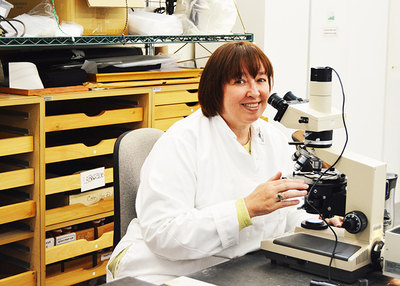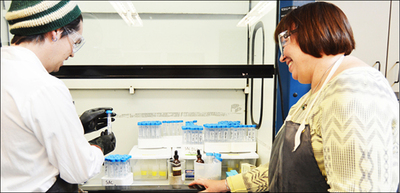Scholarship opens doors to the past for future archaeologists
Judith Habicht Mauche, professor emerita of archaeology, is a modern-day pioneer who has established an endowed scholarship that will preserve programs and experiences in human exploration and develop the next generation of UCSC-trained archaeologists.

For Judith Habicht Mauche, Professor Emeritus, studying ancient pottery brings the stories of ancient peoples to life—giving today’s archaeologists a glimpse into people and cultures that have shaped Native American history. It also offers students the opportunity to practice scientific methodologies and develop skills that can be applied to numerous disciplines. Her contributions to the field of archaeology, her extensive research, and her three-decades-long service to UC Santa Cruz, have left an indelible legacy. Upon her recent retirement, Habicht Mauche established an endowed scholarship to preserve the programs and experiences in human exploration that will open doors to the past for the next generation of UCSC-trained archaeologists.
Childhood road trip inspired lifelong journey through the past
Cross-country road trips can create memories that last a lifetime, and for Habicht Mauche, one such trip inspired a passion that would form the foundation of her lifelong career. At age 12, she and her parents embarked on a family road trip from Buffalo, NY, to Southern California. They visited communities in New Mexico and Arizona, learning about aspects of Pueblo and Native American culture, history, and modern life. While sitting on a bench with her father after a day exploring the historic Pueblo Bonito in Chaco Canyon, NM, Habicht Mauche told her father she aspired to be an archaeologist and work in the Southwest. The road trip ignited a passion that led to a decades-long career in a niche field of study—ancient ceramics.
Blending Ancient History with Modern Technology
The study of ancient ceramics, which gives archaeologists insight into how people lived and interacted with one another, is quite complex, says Habicht Mauche. It requires the complex merger of methodologies from the natural sciences, particularly chemistry, geochemistry and physics in order to answer questions about the human experience. Habicht Mauche’s specialty is petrography, or optical mineralogy, a geological technique first applied to the study of ancient pottery in the Americas by Anna O. Shepard in the early 20th century.
“Petrography allows us to analyze the pottery and source it—determine what it’s made of, how it was made, and if we are lucky—where it was made,” said Habicht Mauche.
“Ancient potters were material scientists,” she said. “Clay pots were the first human-made manufactured materials, ancient technology. They were able to construct materials that could go through a firing process and come out with properties that would allow them to be heated and cooled over and over. They were making something beautiful but also incredibly functional. The technology involved in making pottery is surprisingly sophisticated and complex.”
It’s the combination of the complex science, the art, and the fact that it was most likely women behind the invention, that attracted Habicht Mauche to the field. An esteemed academician, she earned a Ph.D. in Anthropology from Harvard and developed into an acclaimed expert in petrography and other techniques used for sourcing artifacts and reconstructing ancient trade routes. Her specialization is in ceramic analysis. She has been the principal investigator on a number of grant-funded research projects throughout her celebrated career and has been a distinguished lecturer and contributor to worldwide journals and publications.

Honoring a pioneer and lifting the next generation
Foundational to Habicht Mauche’s career was the work of Shepard, an early trailblazer for women in the sciences and a demigod of ancient ceramics in the American Southwest and Mesoamerica. An archaeologist and geochemist in the early 1930s, Shepard was one of the first people to utilize petrography to study ancient ceramics, which Habicht Mauche has used in her work and taught in her courses at UC Santa Cruz.
“All of us stand on her shoulders – those of us who study pottery and especially those of us who use archaeometry techniques. We owe her a huge debt for showing us the way,” said Habicht Mauche.
“To the extent that ceramic studies, to some degree, are dominated by women scholars, it opened a field for women in archaeology. It led me to see a place for myself in the discipline. I have tried to build on the work that she has done.”
Habicht Mauche is paying homage to Shepard by naming the scholarship, the Anna O. Shepard Archaeological Futures Endowment Fund in the Division of Social Sciences to support the Archaeological Research Center (ARC) and student research in archaeology.
“It’s important that we support future generations of archaeologists,” said Habicht Mauche. “My generation could ask our parents for financial support. This generation does not have the same depth of support. This endowment will not only help students participate in field studies, attend conferences or do research; it will provide financial stability to enable future generations to have these enrichment opportunities that are so critical to their academic experience and professionalization.”
Experiential opportunities, such as field school and museum visits, are essential and also expensive, says Habicht Mauche, who hopes her support of the new endowment will inspire others to recognize the need to sustain these activities.
“When students get out of the classroom, they can see how archaeology is done and can experience how knowledge is created. When they can work in a faculty member’s lab and don’t have to worry about funding supplies, they can focus on learning how science is done. When we can bring in experts, it expands students’ professional network, which is critical in this field.”
A Modern-Day Anna Shepard
Habicht Mauche, has, like Shepard, paved the way for many women and men to advance the field of ceramic archaeology. She was one of only two faculty members when she arrived at UC Santa Cruz, and helped build and lead the department into an emerging world leader with its advanced laboratories, renowned faculty and regional specializations. She was instrumental in launching the doctoral program, establishing the ARC and recruiting esteemed faculty.
“The department’s faculty, with diverse backgrounds, fits the movement within archaeology to be more responsive to indigenous communities; to be more politically engaged; to make our work more relevant; to understand ourselves as historians telling particular stories about people and understanding the impact of those stories on the people in the world today,” she said.
After a storied 31-year career at UC Santa Cruz, Habicht Mauche is living in Santa Fe, NM, one of the stops on the career-defining childhood road trip. Of her extensive list of contributions to the university and the field of ceramic archaeology, she is most proud of her students.
Many of Habicht Mauche’s former students have garnered recognition for their significant contributions to archaeology in a variety of industries. Jun Sunseri (M.A. Anthropology, ’03 Ph.D. Anthropology, ’09) received the chancellor’s Post-Doctoral Fellowship at UC Berkeley, where he is an associate professor of anthropology. Dr. Sarah Peelo (Ph.D., Anthropology, ’09) is president and a co-owner of Albion Environmental, a cultural and natural resource consulting firm in Northern California. Dr. Danielle Dadiego (M.A. Anthropology, ’17; Ph.D. Anthropology, ’20) was recently awarded the Society for American Archaeology Dissertation Award; she is a lecturer at the University of West Florida. Dr. Suzanne Eckert (Crown College, Anthropology, ’92) is head of collections at the Arizona State Museum.
“UCSC students are a special breed; they are risk takers and knowledge seekers who want to change the world. They want to make archaeology more relevant to today’s world, more equitable, more ethical. I’m so proud of who they are and their contributions to archaeology, higher education and many other fields.”